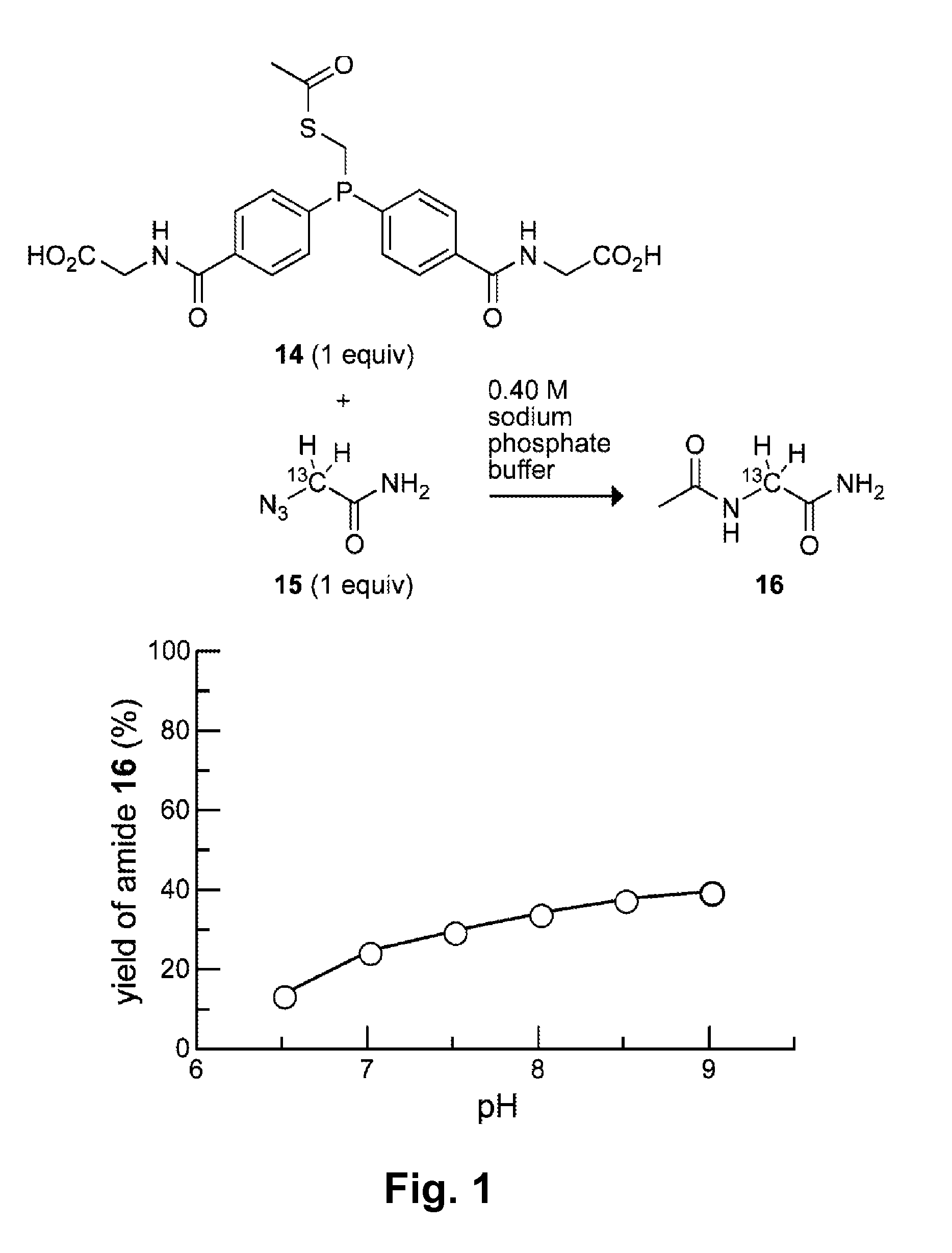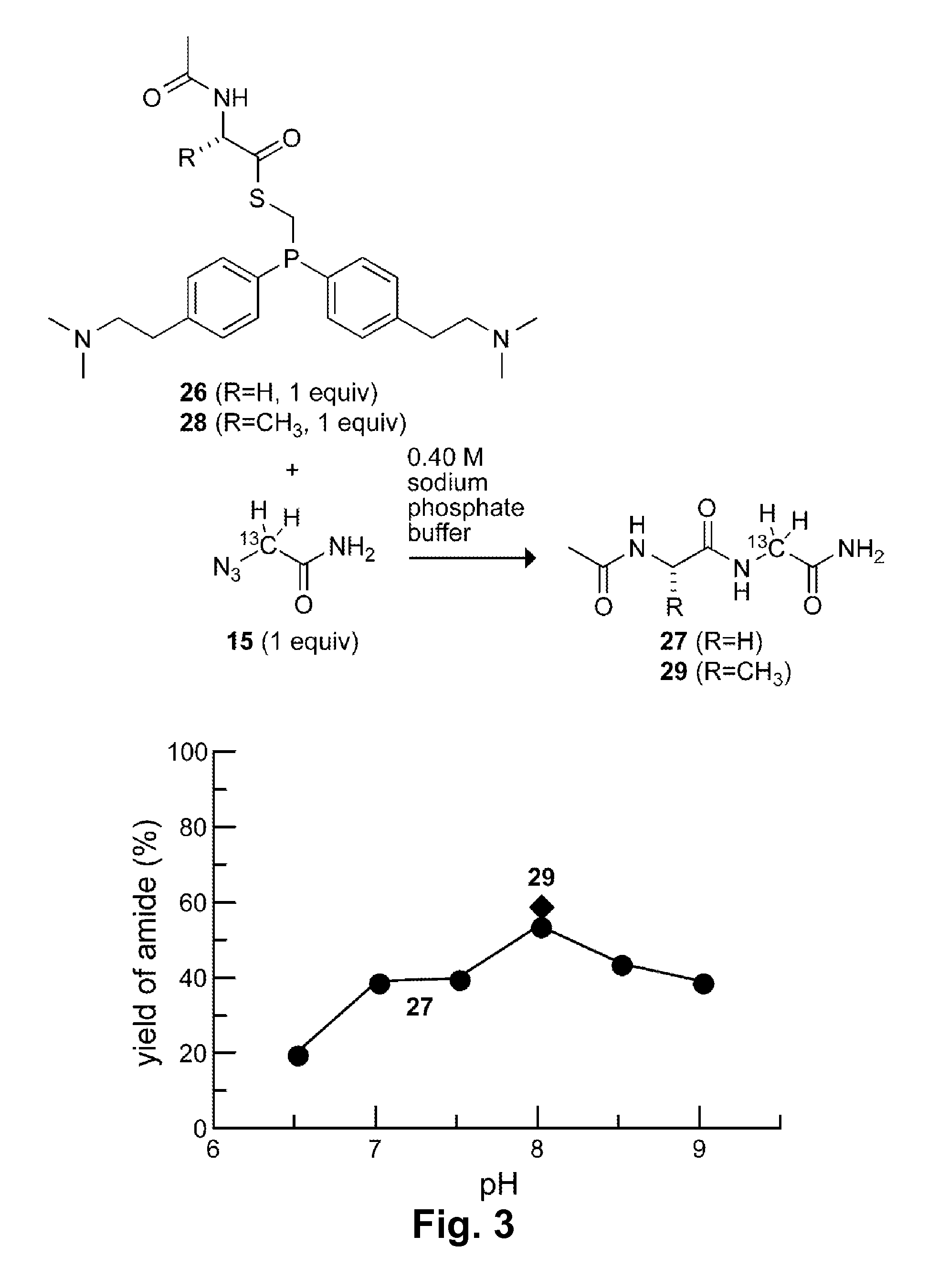Water-soluble phosphinothiol reagents
a phosphinothiol and water-soluble technology, applied in the field of peptide chemistry, can solve the problems of inability to create this type of linkage, severe limitations, and inability to prepare most proteins,
- Summary
- Abstract
- Description
- Claims
- Application Information
AI Technical Summary
Benefits of technology
Problems solved by technology
Method used
Image
Examples
example 1
[0074](Diphenylphosphino)methanethiol (1) is the most efficient known phosphinothiol for ligating peptides to form a junction at a glycine residue. (Nilsson, B. L.; Kiessling, L. L.; Raines, R. T. Org. Lett. 2001, 3, 9-12; Soellner, M. B.; Nilsson, B. L.; Raines, R. T. J. Am. Chem. Soc. 2006, 128, 8820-8828.) Recently, the p-methoxy-substituted phosphinothiol 2 was shown to afford high yields at non-glycyl residues. (Soellner, M. B.; Tam, A.; Raines, R. T. J. Org. Chem. 2006, 71, 9824-9830.)
[0075]Although they have desirable attributes, neither of these phosphinothiols is soluble in water. Indeed, all traceless Staudinger ligations have been performed in organic solvents or organic / aqueous mixtures. The ability to effect the traceless Staudinger ligation in water expands the utility of the Staudinger ligation. In particular, the possibility of carrying out transthioesterification with a water-soluble phosphinothiol would enable the generation of phosphinothioesters at the C terminus...
example 2
[0126]The amino groups of phosphinothiol 17a (which become positively charged at appropriate pH) are eight bonds away from the key iminophosphorane nitrogen in the mechanism in Scheme 2. Even at this distance, however, through-space Coulombic effects can affect pKa values. For example, CH3(CH2)8NH3+ has a pKa of 10.65. (Brown, H. C.; McDaniel, D. H.; Hafliger, O. In Determination of Organic Structures by Physical Methods; Braude, E. A., Hachod, F. C., Eds.; Academic Press: New York, 1955; pp 567-662.) The addition of a positive charge, as in +H3N(CH2)8NH3+, lowers the pKa to 10.10. Likewise, CH3(CH2)5NH3+ and +H3N(CH2)5NH3+ have pKa values of 10.63 and 9.74, respectively. (Brown, H. C.; McDaniel, D. H.; Hafliger, O. In Determination of Organic Structures by Physical Methods; Braude, E. A., Hachod, F. C., Eds.; Academic Press: New York, 1955; pp 567-662.) As noted in Example 1, long-range Coulombic effects were also evident in attempts to mediate the traceless Staudinger ligation in ...
PUM
| Property | Measurement | Unit |
|---|---|---|
| water soluble | aaaaa | aaaaa |
| pH | aaaaa | aaaaa |
| water-soluble | aaaaa | aaaaa |
Abstract
Description
Claims
Application Information
 Login to View More
Login to View More - R&D
- Intellectual Property
- Life Sciences
- Materials
- Tech Scout
- Unparalleled Data Quality
- Higher Quality Content
- 60% Fewer Hallucinations
Browse by: Latest US Patents, China's latest patents, Technical Efficacy Thesaurus, Application Domain, Technology Topic, Popular Technical Reports.
© 2025 PatSnap. All rights reserved.Legal|Privacy policy|Modern Slavery Act Transparency Statement|Sitemap|About US| Contact US: help@patsnap.com



